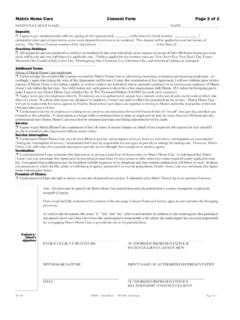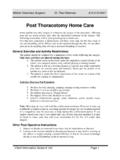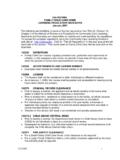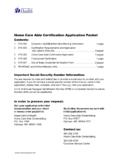Transcription of LARYNGECTOMY HOME CARE (12/05)
1 2201 Glenwood Ave., Joliet, IL 60435. ENT SURGICAL CONSULTANTS (815) 725-1191, (815) 725-1248 fax Thomas K. Kron, MD, FACS 1300 Copperfield Ave., Suite 3060, Joliet, IL 60432. Michael G. Gartlan, MD, FAAP, FACS (815) 727-6031. Rajeev H. Mehta, MD, FACS. Scott W. DiVenere, MD 119 E. Jefferson St., Morris, IL 60450. (815) 941-1972. Sung J. Chung, MD. Ankit M. Patel, MD. LARYNGECTOMY home care (12/05). Your larynx or voice box is a structure of muscle and cartilage at the upper end of the trachea (windpipe). This area of the neck is commonly referred to as the Adam's apple. The larynx contains the vocal cords, which serve two very important functions. The vocal cords move together to allow us to speak and move apart to allow us to breathe. A total LARYNGECTOMY is a surgical procedure (operation) that removes the entire larynx. As a result, breathing and speaking will be forever altered after the surgery. How will my breathing be different? This is probably the biggest change you will face.
2 After surgery you will have a permanent hole in your neck called a stoma. This stoma connects directly to your trachea (windpipe) which leads to your lungs. All of the air you breathe passes through this stoma ( , no air passes through your nose and mouth). As a result, the sensation of breathing is different. Because this is your only breathing passage, ensuring that this stoma is clear is of vital importance. This permanent opening between the trachea to the surface of the neck is sometimes referred to as a tracheostomy. While a tracheostomy stoma and LARYNGECTOMY stoma appear quite similar, they are not the same. A tracheostomy is a fork in the road, with some of the air passing through the stoma and some passing up through your voice box and out your nose and mouth. As mentioned earlier, with a LARYNGECTOMY the only route the air can take is through the stoma. As a result, the true term for this type of opening is LARYNGECTOMY stoma. Will I ever be able to speak again?
3 In almost all people, the answer to this question is a resounding YES! A speech pathologist may see you before and definitely after surgery and will give you instructions on an alternate method of speaking. You may need to communicate in writing until you learn one of these alternate methods. In the past, 2 options existed: 1) artificial larynx (electrolarynx). This is a vibrating device that is held up to the neck while the person mouths the words. While easy to learn and generally quite effective, speech is certainly quite robotic and artificial; and 2) esophageal speech. This is basically speaking while belching. While some learn to perform this amazingly well, it takes a great deal of training and many are never able to master it. Today, the primary option for voice restoration is through a voice prosthesis (generally a Provox 2) that is inserted either at the time of surgery or afterward. This prosthesis is inserted through the back wall of the stoma and serves as a connection between the trachea and the esophagus.
4 Because this method allows lung-generated air to pass through your own mouth and lips, the quality of the speech is generally much more natural. The voice prosthesis is inserted either at the time of the original surgery or several weeks after. Generally, speech therapy begins within several weeks after the LARYNGECTOMY and effective speech is usually achieved very quickly. This is successful for approximately 90% of all LARYNGECTOMY patients. What should I expect after surgery? After surgery you will be admitted to the Intensive care Unit to be closely monitored. You will be hooked up to an IV, EKG and humidified oxygen as routine monitoring while in the Intensive care Unit. It is normal to experience swelling to the neck and face, which will gradually decrease day by day. Some other changes you may experience after your LARYNGECTOMY are: Decreased ability to smell because you are unable to inhale odors through your nose. Decreased ability to taste because taste sensation is greatly affected by odors and ability to smell.
5 Inability to blow your nose because you cannot exhale air through your nose. Inability to hold your breath and bear down (Valsalva maneuver). Inability to warm, moisten and filter the air you inhale because these functions previously took place in your nose and mouth. It is important that you know about these changes, as this will help you understand your home care instructions and why they are necessary. You will be given individual instructions, demonstrations, and practice sessions before you are discharged so you will be able to care for yourself effectively. A family member of friend should also learn how to care for you and practice helping you so that 1. someone can assist you at home . This handout summarizes what will be taught and should be kept as a resource for you and your family/friend. HOW TO care FOR YOUR AIRWAY. In most cases the use of normal saline and a humidifier effectively keeps your secretions thin enough to cough or suction out.
6 If you have thick secretions, mucous plugs, or a feeling that your airway is not clear, you may try the following suggestions: 1. Fill the bathtub with hot water and sit in the steam-filled bathroom for 20 minutes. Do not submerge in the bathtub. Repeat as necessary. 2. Place a moist all-gauze square over your stoma. Remoisten it frequently. The gauze may be held in place by folding it over twill tape or bias tape and securing it around your neck. 3. Stand in the shower with the water directed away from your stoma. 4. Fill an atomizer or spray bottle with normal saline and spray into your stoma several times a day. SUCTIONING. The purpose of suctioning is to remove secretions that you cannot cough out. Suctioning will clear your airway, making it easier to breathe. 1. Connect suction catheter to tubing from suction machine. 2. Instill 2 to 3cc of normal saline into the stoma to loosen secretions. 3. Moisten the tip of the catheter in a small container of normal saline.
7 4. Breathe deeply before inserting the catheter. 5. Gently insert the catheter through the stoma. Do not cover the suction control vent while inserting the catheter. Pass the catheter until you meet resistance, then withdraw slightly before applying suction. 6. To apply suction, cover the vent with your thumb. Do not apply suction for more than ten seconds. Gently rotate the catheter as it is withdrawn. 7. Do not insert the catheter more than three times during one suctioning period. If the additional suctioning is required, allow yourself a five- or ten-minute rest before suctioning again. HOW TO MAKE NORMAL SALINE. 1. Carefully clean and rinse a 1-quart glass jar. Fill the clean jar with tap water or bottled water. You do not have to boil the water. 2. Add one heaping teaspoon of pickling/canning salt. Do not use table salt. Table salt has unwanted additives. You can ask for pickling salt at the grocery store. It is often difficult to find during the winter months.
8 3. Add 1 rounded teaspoon of baking soda (pure bicarbonate). 4. Stir or shake before each use. Store at room temperature. After a week, pour out any mixture that is left over and make a new recipe. HOW TO care FOR SUCTION EQUIPMENT. Cleaning the Suction Catheters: 1. Place catheters under cool running tap water to rinse secretions. 2. Wash catheters well in hot, soapy water (mild liquid soap) and rinse thoroughly with tap water. It may be helpful to attach the catheter to suction to remove any remaining soapy water. 3. Soak catheters in equal parts of white vinegar and tap water (one cup vinegar to one cup water) for one hour. Rinse suction catheters with normal saline and connect catheter to suction to rinse inside of each catheter. 4. Air dry catheters on a clean towel. 5. Store catheters in a clean, covered container. care of Suction Machine: 1. Dispose of secretions from the suction bottle into the toilet. 2. Wash the suction bottle and tubing daily with hot, soapy water.
9 HAND-WASHING/CLEAN TECHNIQUE. The importance of hand washing cannot be overemphasized. Because your hands may spread germs, it is essential that you wash your hands before and after all care , and clean equipment must be used. HUMIDITY. Additional moisture is necessary because the nose and mouth, which normally filter, warm and moisten the air you breathe, are bypassed. The required amount of additional moisture will vary. Use a room-size humidifier in your bedroom in addition to the furnace humidifier. Drinking plenty of fluid also helps to keep your airway moist. Increased humidity will be essential during the winter months when your home becomes dry. More moisture is needed whenever tracheal secretions become thick, dry, or form plugs. Pink or blood-tinged secretions may also indicate a lack of moisture. Putting normal saline (a salt solution) into the trachea adds moisture 2. and stimulates a cough to clear secretions from your airway. You will be able to tell how often to instill normal saline by the type and amount of secretions.
10 HOW TO CLEAN THE HUMIDIFIER. Germs will grow in a humidifier making it necessary to clean the unit to decrease the possibility of respiratory infections. Refer to package instructions for specific cleaning methods. Daily: 1. Empty and clean tub with hot soapy water. Rinse well. 2. Fill with fresh tap water. 3. Never add water to the humidifier without emptying and rinsing the tub. Weekly: 1. Empty and rinse. 2. Fill the humidifier tub with equal parts of vinegar and water and turn the humidifier on for one hour. Due to the strong smell of the vinegar, place the humidifier in an unoccupied room. 3. Empty the humidifier and wash all parts with hot soapy water. Rinse well. 4. Fill the tub with clean water and turn on the humidifier for another hour. 5. Empty and air-dry. Unit is ready for use. HOW TO care FOR YOUR STOMA. A skin care nurse will assist you with cleaning and caring for your LARYNGECTOMY tube and stoma while you are in the hospital. The skin care nurse will work together with your physician for your individual needs.








